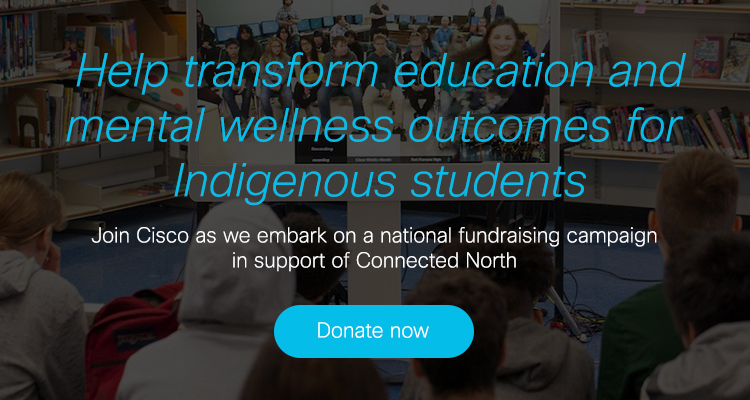
Stories of Connected North: Terry Taylor – Expanding possibilities for Indigenous youth
4 min read
Terry Taylor is a Systems Engineer with Cisco Canada, based out of Winnipeg, Manitoba. He is one of six Cisco engineers who have been involved with the Connected North program, installing the Cisco videoconferencing endpoints which are essential to the delivery of the program. I sat down with Terry to discuss his involvement with the program. Our interview has been edited for length.
NA: How and why did you become in involved in the Connected North program, and what does your role entail?
TT: Before I joined Cisco, I worked for a company which has about 200 northern stores across northern Canada—and I had been there for 13 years. When the Connected North program was starting, I was asked about my knowledge of the north, and I said I travelled to most of the communities up there. So, I was asked if I could possibly go out and do a couple of the first installs to help things along and I jumped at the chance… it sounded like a great opportunity! So, I started helping do the installs in Arviat, and then I followed it up with Carcross last year.
“When I landed in Arviat it had been almost 20 years since I had been there, and I could have drawn you a map of the place. Nothing had changed. There’s no growth, no change.”
NA: Where do you think the Connected North program is headed next, and are there any new technologies driving this?
TT: I think it’s headed for greatness. I think it’s amazing technology and program, and I think that the next thing we should be looking at for these communities is trying a Spark Board for real time [ongoing] collaboration that can have images brought up, annotated on and shared between schools. I think that would be really neat to see! And I think we should definitely try and seed that into the next Connected North site.
NA: How has the Connected North program impacted your life?
TT: It’s given me a much greater respect for what we have in the south. You know, again, I’m a little bit different just because I had seen a lot of the north, and it’s one of these things where I go on trips all the time—and you drive to the airport and see a building being built, and come back two weeks later and you see the progress on it. When I landed in Arviat it had been almost 20 years since I had been there, and I could have drawn you a map of the place. Nothing had changed. I mean, it’s absolutely identical to the way that it was 20 years ago with the exception of a new school. There’s no growth, no change, and it’s very depressing to see that. So, I think it’s given me a much greater appreciation for what we have down [south] in the schools. I have a nine-year-old son, and to see his school and the resources that he has available—it definitely makes you want to help more and to give these kids up north something that makes them want to come to school.
“These kids [up north] have no life experiences outside of 50 or 60 miles from their house. That’s what makes me think the program is so good. It gets these kids to experience things outside of their communities.”
For example, we were in Carcross and one of the facilitators from TakingItGlobal came on [the video unit] and said: “You guys, this is a brand new technology and I want to be able to share a play with you, and you get to pick wherever in the world you want the play being done from!” He kept saying, “you guys decide, I’ve got people all over the world—you decide where you want the play to be and I’ll find a person there. Where do you want it?” and the kids all went, “Whitehorse!” Whitehorse is only about 50 minute drive away from Carcross.
And he’s like, “no, think big, anywhere in the world, anywhere you guys want to go.” And the kids were all a little bit sheepish, and they said “Edmonton?” I was in the classroom and you could tell the facilitator was a bit lost on what to say next.
Their world revolves around Carcross and Whitehorse, and a few of them know about Edmonton. When I went home – my son was about 8 at the time – and I asked him the same question. “If you could watch a play performed anywhere in the world, where would you want it to be?” His very first answer was the Sydney Operahouse. Then he said the pyramids in Egypt. He went on naming all this stuff. They were covering the Middle East in school, so he named off places that I hadn’t even heard of. The difference was absolutely incredible. These kids [up north] have no life experiences. My son has been all over the place in Canada and the United States, and these kids, they don’t have any life experiences outside of 50 or 60 miles from their house. That’s what makes me think the program is so good. It gets these kids to experience things outside of their communities.
NA: If you could describe Connected North in a single word, what word would that be?
TT: Hope.
Click here to read Willa Black’s Story, “New Opportunities, New Connections” >>
